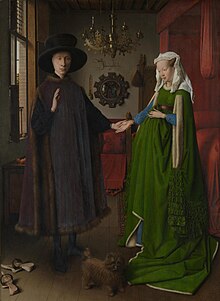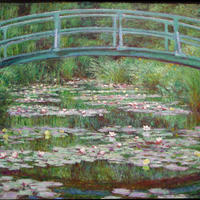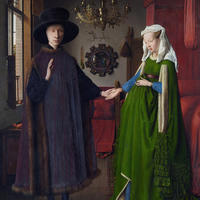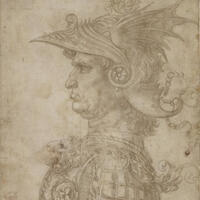More about Jan van Eyck
- All
- Info
- Shop

Sr. Editor
Jan van Eyck came from a large family of talented painters, of which he was without doubt the star.
He was also so good with oil paint that a myth emerged that he'd invented it. Before this time, most artists used egg tempera instead of oil-based paint. Tempera paints dried very fast and did not allow for any translucency. That meant no special effects.
Van Eyck was a master of extreme detail. Look closely at his paintings and you will see individual hairs, sweat, and gleaming jewels. He practically invented realism. Some of his contemporaries thought he was huge cheater because he used mirrors to project the subject onto the canvas and trace it before filling in with oil paints.
As a court painter to Philip the Good, Duke of Burgundy, van Eyck made tons of money. He was one of the few wealthy artists of his time.
He was also godfather to Philip's children, a diplomat, and an all around right hand man. In addition to painting, the Duke sent him on various sometimes-secret missions as an ambassador. On one trip he went to Portugal to paint a portrait of the duke’s future bride Isabella of Portugal. They had no cameras in those days and the duke had never laid eyes on Isabella.
As Van Eyck’s reputation grew, he didn’t mind a little self-promotion. He was one of the first artists to sign and date his work. He also wrote his personal motto Als ich kan (As well as I can) on his canvases.
Van Eyck's style was super popular and so you might accidently confuse his work with other artists of the time like Rogier van der Weyden and Robert Campin.
Featured Content
Here is what Wikipedia says about Jan van Eyck

Jan van Eyck (/væn ˈaɪk/ van EYEK;
Dutch: [ˈjɑɱ vɑn ˈɛik]; c. before 1390 – 9 July 1441) was a Flemish painter active in Bruges who was one of the early innovators of what became known as Early Netherlandish painting, and one of the most significant representatives of Early Northern Renaissance art. According to Vasari and other art historians including Ernst Gombrich, he invented oil painting, though most now regard that claim as an oversimplification.
The surviving records indicate that he was born around 1380 or 1390, in Maaseik (then Maaseyck, hence his name), Limburg, which is located in present-day Belgium. He took employment in The Hague around 1422, when he was already a master painter with workshop assistants, and was employed as painter and valet de chambre to John III the Pitiless, ruler of the counties of Holland and Hainaut. After John's death in 1425, he was later appointed as court painter to Philip the Good, Duke of Burgundy, and worked in Lille before moving to Bruges in 1429, where he lived until his death. He was highly regarded by Philip, and undertook a number of diplomatic visits abroad, including to Lisbon in 1428 to explore the possibility of a marriage contract between the duke and Isabella of Portugal.
About 20 surviving paintings are confidently attributed to him, as well as the Ghent Altarpiece and the illuminated miniatures of the Turin-Milan Hours, all dated between 1432 and 1439. Ten are dated and signed with a variation of his motto ALS ICH KAN (As I (Eyck) can), a pun on his name, which he typically painted in Greek characters.
Van Eyck painted both secular and religious subject matter, including altarpieces, single-panel religious figures and commissioned portraits. His work includes single panels, diptychs, triptychs, and polyptych panels. He was well paid by Philip, who sought that the painter was secure financially and had artistic freedom so that he could paint "whenever he pleased". Van Eyck's work comes from the International Gothic style, but he soon eclipsed it, in part through a greater emphasis on naturalism and realism. He achieved a new level of virtuosity through his developments in the use of oil paint. He was highly influential, and his techniques and style were adopted and refined by the Early Netherlandish painters.
Check out the full Wikipedia article about Jan van Eyck




























